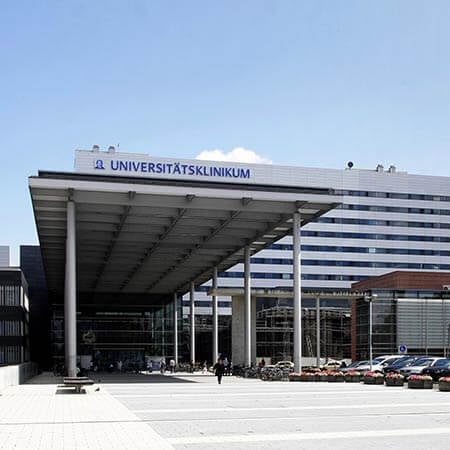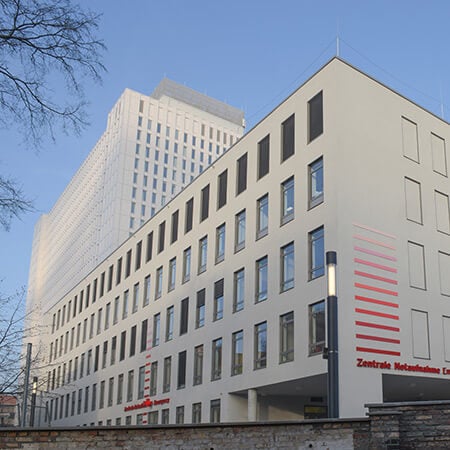Cysts are tumor-like formations of the ovaries. They can be classified as functional or organic. Functional cysts (corpus luteum and follicular) disappear on their own within a few months, while organic ones require surgical removal. If you have a cyst in your ovary, you can opt to undergo your treatment abroad. Doctors in developed countries perform safe and minimally invasive interventions, during which measures are taken to maintain sufficient ovarian reserve so as not to impair a woman's reproductive function. You are welcome to visit the Booking Health website, where you can find out the cost of treatment and choose a program at the best price.
Content
- Diagnostics
- Conservative treatment
- Puncture, aspiration, and sclerotherapy
- Surgical approaches for removing ovarian cysts
- Types of operations for ovarian cysts
- Why to undergo your treatment abroad?
Diagnostics
In most cases, ovary cysts cause no symptoms. In some cases, they may reach gigantic sizes, so women complain of a volumetric formation in their abdomen, which can be palpated through the anterior abdominal wall.
The diagnosis can be confirmed with an ultrasound scan. The technique is very informative and allows doctors to fix the fact of the presence of a cyst, distinguish a cystic formation from a dense one (tumor), and a functional cyst from an organic one with an accuracy of 97%. Ultrasound scans are performed with a vaginal probe. Giant cysts can be detected with transabdominal (through the abdomen) ultrasound scans.
A contrast-enhanced MRI scan may be required, although this diagnostic method is uncommon as it is conducted for patients with suspected malignant processes.
Diagnostic laparoscopy is an uncommon diagnostic procedure. This is a minor operation through a short incision in the abdomen. A doctor inserts a tiny video camera inside to examine the abdominal cavity.
Laboratory tests may be used to determine the risk of ovarian cancer. Doctors determine tumor marker levels in the patient's blood. The IOTA, RMI, and ROMA indices are used to calculate the risk. The technique is usually used in the presence of ultrasound signs indicating a malignant process (multi-chamber cysts, dense components, or strong blood flow when using Doppler scanning).
Conservative treatment
There are no conservative treatment options that would completely eliminate ovary cysts.
Follicular and corpus luteum cysts may disappear on their own over time. Previously, combined oral contraceptives were prescribed for their treatment, but now medicines are not used, as studies have shown that the likelihood of cyst regression is the same with and without drug treatment. Such formations are therefore controlled with a watchful waiting approach. This means that doctors periodically conduct ultrasound scans and look at how the size of the cyst has changed. They usually note its gradual regression. If the cyst grows to 6 cm in size, causes any symptoms, does not regress within six months, or even grows larger for three months in a row, a woman is advised to have the formation removed.
Women with endometrioid cysts receive treatment with conservative methods, but the effect is temporary. Doctors prescribe drugs that cause a state close to menopause. In this case, the foci of endometriosis in the body are reduced, including those in the ovaries. But it is impossible to use such a therapy throughout life, and after its cancellation, endometrioid cysts will grow larger again. Therefore, hormone treatment is considered only a preparation for an operation. During this treatment stage, doctors can shrink ovary cysts for their easier removal in the future.
Puncture, aspiration, and sclerotherapy
A minimally invasive procedure can be used instead of an operation for the treatment of ovarian cysts. This procedure consists of a transvaginal puncture with aspiration of the contents of the ovary cyst and the introduction of a sclerosing agent under ultrasound guidance.
This is a minimally invasive procedure that can be completed in one day with no hospital stay. It is performed under short-term intravenous anesthesia. Doctors insert a needle through the vagina into the ovary, pierce the cyst, and remove its contents. A sclerosant is then injected inside. This substance damages the walls of the cyst and causes them to stick together so that the fluid does not accumulate again.
The technique is not widely used because it has a number of disadvantages. These are the following:
- the procedure does not allow doctors to be sure that there is no cancer, as they do not receive any material for a histological examination, and a cytological examination of the fluid is not very informative since, even in the case of cancer, it gives two-thirds of false negative results;
- some authors warn of a high risk of cyst recurrence, namely 75% with long-term follow-up, although the risk decreases with each subsequent procedure.
This treatment method can sometimes be used for endometrioid cysts and symptomatic functional cysts with a low risk of cancer in women with contraindications for surgery.
Surgical approaches for removing ovarian cysts
A standard treatment of ovarian cysts is their surgical removal. Below are some options for operations classified by type of surgical approach:
- laparotomy is performed through a large incision in the abdomen;
- laparoscopy is performed through short incisions;
- a transluminal approach implies an incision in the vagina.
Laparotomy is not a common treatment option in developed countries, as this operation is traumatic and requires long-term rehabilitation. It is done only for gigantic cysts, suspected cancer, complications, and in the absence of technical capabilities for laparoscopy.
Laparoscopy is the main method of performing gynecological operations at hospitals in developed countries. If you are undergoing your treatment abroad, the operation will be minimally invasive. All manipulations are performed through 3-4 small incisions with thin, long instruments, which allows for a reduction of the rehabilitation period by 2-3 times. Some hospitals practice single-port laparoscopic surgery when the intervention is performed through just one incision in the navel. The main advantage of this method is considered to be a good aesthetic result, as there will be no unattractive scars on your abdomen. If you use the services of the Booking Health company, we will select for you a hospital whose doctors have a perfect command of single-port laparoscopy.
Transluminal surgery (NOTES) is not a standard treatment but is practiced at some hospitals. Doctors perform the intervention through the vagina. An incision remains inside, and there is not a single scar on the abdomen after the operation. The surgical intervention is comparable in its effectiveness to laparoscopy, but in some cases, most often in patients with adhesive disease, it may be necessary to implant an additional port through a short abdominal incision. NOTES operation is the least traumatic, so it is followed by a mild postoperative period with the least severity and duration of postoperative pain. The disadvantage of NOTES is considered to be the long duration of the operation compared to standard laparoscopy. This type of surgery is not used for grade 3-4 adhesions, as the risk of switching to standard laparoscopy in such women reaches 90%.
Types of operations for ovarian cysts
Surgical options for ovarian cysts include the following:
Cystectomy and cyst enucleation implies the removal of only the cyst while preserving the ovary. Doctors do not open the formation cavity to prevent the spread of cancer cells in the abdominal cavity, if any. The cyst is placed in a special container before being safely removed to the outside environment.
Ovarian resection is a surgical procedure to partially remove an organ. It is not very common, since most women with ovary cysts are young patients, and many of them have reproductive plans. Doctors therefore strive to preserve as much ovarian tissue as possible so as not to reduce the supply of eggs.
Adnexectomy is the surgical removal of the ovary along with a fallopian tube. This is a rare operation that is sometimes performed due to the development of complications. Women can preserve their fertility after it, since the second ovary and fallopian tube remain.
Ovariectomy is essentially the same treatment option, but only the ovary is removed and the fallopian tube is preserved.
Bilateral adnexectomy is a surgical procedure for women at high risk of ovarian cancer that is performed only after menopause. Doctors remove both ovaries and both fallopian tubes while preserving the uterus.
Doctors at hospitals in developed countries prefer sparing operations that preserve as much viable ovarian tissue as possible. Foreign gynecologists take additional measures so as not to reduce the ovarian reserve. They perform tissue coagulation with hemostatic drugs instead of electrical or other energy so as not to "cauterize" normal ovary tissue along with bleeding blood vessels.
Why to undergo your treatment abroad?
Diseases of the ovaries, the cervix of the uterus, the body of the uterus, and other organs of the female reproductive system are best treated abroad, especially if surgery is planned. In this case, you can expect the treatment to go smoothly, with a short recovery time and good long-term results. You are welcome to visit the Booking Health website to see the cost of treatment at various foreign hospitals.
There are a few reasons for you to undergo your treatment abroad. These are the following:
- accurate diagnostics allows distinguishing a functional cyst from an organic one and assess the risk of a malignant process to determine the best treatment tactics;
- operations are performed with the use of minimally invasive laparoscopic techniques;
- the best hospitals use innovative surgical techniques, including single-port laparoscopy, robot-assisted surgery, and transluminal surgery;
- the most sparing removal of ovary tissue while maintaining the ovarian reserve to avoid infertility;
- the use of sparing methods of hemostasis (bleeding stop) so as not to injure or destroy the remaining ovary tissue;
- rapid rehabilitation, full care, and symptomatic treatment in the postoperative period.
The best choice for diseases of the ovaries, the body of the uterus, and the cervix is treatment abroad. Thus, you will get rid of the pathology once and for all without any significant health risks and a long recovery period. After two weeks, you will return to your normal life.
On the Booking Health website, you can find out the cost of treatment and choose a medical care program at the best price. We will help you choose the most suitable hospital, organize a doctor's consultation, and arrange your treatment abroad. The cost of treatment for you will be lower than when you seek medical attention directly from the hospital, due to the absence of taxes for foreign patients. The initial price of your program will not increase after the start of your treatment, as you will receive insurance that will cover all additional medical expenses. After the completion of your program, you will have the opportunity to receive medical consultations for 3 months.
Authors:
The article was edited by medical experts, board-certified doctors Dr. Nadezhda Ivanisova and Dr. Vadim Zhiliuk. For the treatment of the conditions referred to in the article, you must consult a doctor; the information in the article is not intended for self-medication!
Sources:
Centers for Disease Control and Prevention
Healthline




















